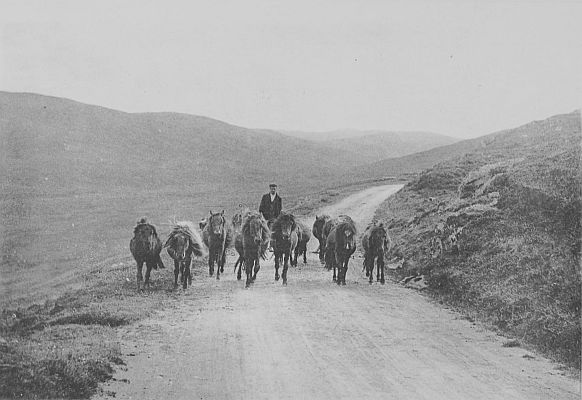THE SHETLAND PONY
Transcriber’s Notes
Footnote anchors have been changed from numeric to an alpha plus numeric sequence such as: [F1] [F2], to create a point of difference between footnotes and endnotes which are also numeric.
Page 43—both spellings of ‘maiseys’ and ‘klibbar’ from the writings of Hibbert of 1820’s and ‘maysies’ and ‘clibber’ from Cowies writings of 1874 have been retained.
Other changes made are noted at the end of the book.

The Shetland Pony
by
CHARLES and ANNE DOUGLAS
With an Appendix on
The Making of the Shetland Pony
By J. COSSAR EWART
GRAVURO AND OTHER ILLUSTRATIONS
William Blackwood and Sons
Edinburgh and London
1913
ALL RIGHTS RESERVED
PREFACE.
This account of the Shetland Pony is intended to give, in brief outline, the chief facts of the history, and some idea of the present character, position, and use of the breed. The time seems opportune for placing on record some recent phases of its development which might otherwise be forgotten.
We are much indebted for information and help to the Ladies Estella and Dorothea Hope, to Mrs Wentworth Hope Johnstone, to Mr Robert Alexander, R.S.A., to Mr Robert Brydon, to Mr R. W. R. Mackenzie, and to Mr W. Mungall.
The illustration of Norwegian rock-drawings[vi] is reproduced from Du Chaillu’s ‘The Viking Age,’ by kind permission of Messrs John Murray & Son.
We are especially grateful that we are allowed to include, as an Appendix to the volume, Mr Cossar Ewart’s very interesting discussion of “The Making of the Shetland Pony.”
C. D.
A. D.
CONTENTS.
| CHAP. | PAGE | |
|---|---|---|
| I. | THE EARLY HISTORY | 1 |
| II. | THE PONY IN SHETLAND | 24 |
| THE FETLAR PONY | 46 | |
| III. | THE MODERN PONY | 48 |
... BU KİTABI OKUMAK İÇİN ÜYE OLUN VEYA GİRİŞ YAPIN!Sitemize Üyelik ÜCRETSİZDİR! |
